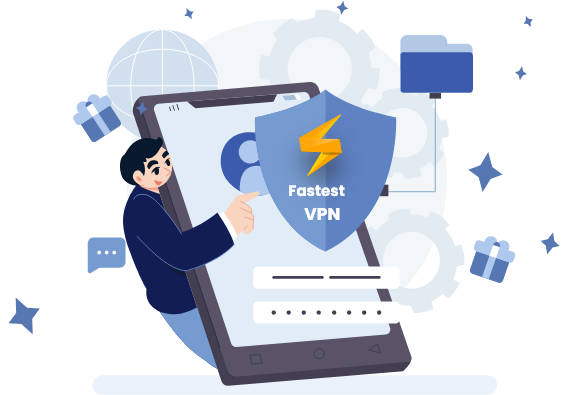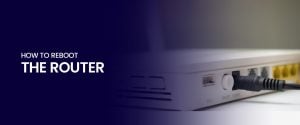

Get 93% OFF on Lifetime
Exclusive Deal
Don’t miss out this deal, it comes with Password Manager FREE of cost.
Get 93% off on FastestVPN and avail PassHulk Password Manager FREE
Get This Deal Now!By Nick Anderson No Comments 5 minutes
Your router may be one of the most uninteresting objects in your space. Yet, it’s one of the most important ones. It connects every device in your home and grants you a gateway to the internet. It’s an important device, and gaining access to the router’s settings gives you much control over the device, including an option to reboot the router.

While that may be a trivial task, but even something as simple as that can leave people, who are not tech-savvy, confused. There may be a concern that rebooting the router would erase the settings preconfigured by the Internet Service Provider (ISP). Let’s discuss all the things you can do in the settings menu and how to reboot a router.
The first thing you need to have to reboot a router is to gain access to the router. You can find the router’s IP address and the username and password you will need to log in to the router. Refer to the router’s back or the product manual for the information.
All routers have a power switch. You don’t even need to get into the settings, just turn it off for ten seconds, then turn it back on.
Routers are little computers with a processor and some amount of memory. It runs firmware that dictates its behavior and makes everything from device management to its core functionality possible.
Just like a computer, your router may get overwhelmed after some time. All the connection requests, incoming and outgoing traffic, firewall management — it may be because of some issues that arise due to the device’s inability to handle too much traffic or its firmware. Rebooting a router refreshes the device.
Your ISP may be limiting your bandwidth. It’s not uncommon to see internet service providers throttle bandwidth when high bandwidth usage has been detected. The repeal of Net Neutrality made matters worse by making things in favor of service providers. Rebooting the router releases the IP address assigned to you by the ISP and fetches a new one.
More often than not, your slow internet speed concerns might get fixed by a simple restart of the router.
Although the words reboot and reset are used interchangeably, they are different when it comes to computers. A reboot simply boots up a device, waking up its functions from zero. A reset is more advanced; it erases user-defined settings and brings the device back to its stock settings. It is also known as a factory reset because it brought the device to its state when it was put in the box at the factory.
If it’s a DSL modem/router that the ISP has configured, resetting will erase those settings, thus leaving you without internet access. Unless you know those settings, you’ll be offline until you get assistance from the ISP.
As we discussed, resetting the router will bring it to stock settings, thereby erasing the settings you have saved. This includes, but is not limited to, ISP’s WAN configuration, IP address and bandwidth allocation, port forwarding, Wi-Fi SSID and password, and the admin panel’s username and password.
Routers have a small hole that is a reset switch. Pushing something as thin as a pin will push the switch and reset the switch. Press and hold for a while until you see the lights on the router turn off and back on again.
Once reset to factory settings, your previous username and password will not work to access the admin panel. Refer to the router’s back or the manual for the default credentials.
The option to reset the router also resides in the admin panel. If you know the credentials to the admin panel, then you’re halfway there.
You will need to configure it again or get it configured by the ISP to access the internet. If the router is an extension of a modem or router, it should return online without any configuration.
As you reset the router, your Wi-Fi settings will go back to default. The SSID name and password will not be usable anymore. Check the back of the router for the default SSID name and the password.
Connect to the Wi-Fi, log in to the admin panel, then change the SSID and password back to how you like it. Connecting via Wi-Fi is not needed if your computer has an ethernet connection to the router.
It is recommended that you keep a password that is hard to guess. Confirm that the router is set to use WPA2 or WPA3 encryption. Most routers today feature WPA2 at least.
There’s an upside to resetting a router. Any unknown devices connected to the router will get disconnected and must connect with the new password. It is one of the ways you can resolve internet speed issues. Check out our blog on how to improve the speed of your internet connection for more insight.
© Copyright 2024 Fastest VPN - All Rights Reserved.


Don’t miss out this deal, it comes with Password Manager FREE of cost.
This website uses cookies so that we can provide you with the best user experience possible. Cookie information is stored in your browser and performs functions such as recognising you when you return to our website and helping our team to understand which sections of the website you find most interesting and useful.
Strictly Necessary Cookie should be enabled at all times so that we can save your preferences for cookie settings.
If you disable this cookie, we will not be able to save your preferences. This means that every time you visit this website you will need to enable or disable cookies again.


